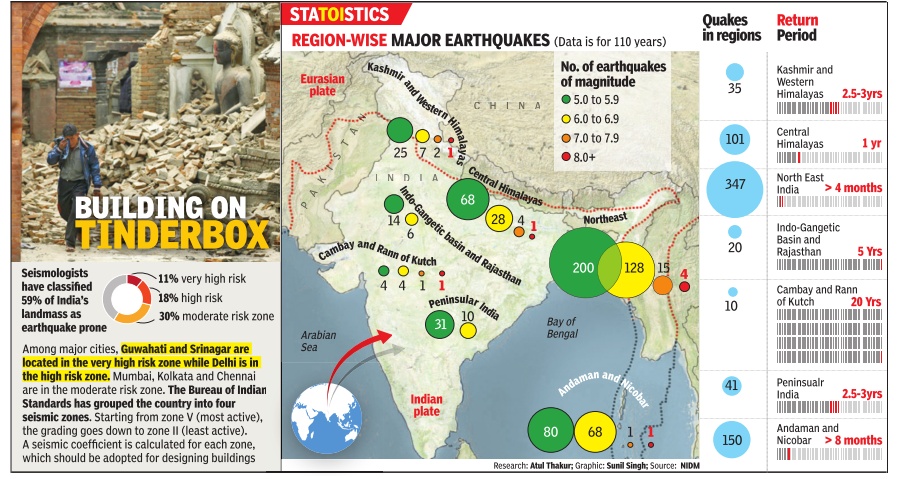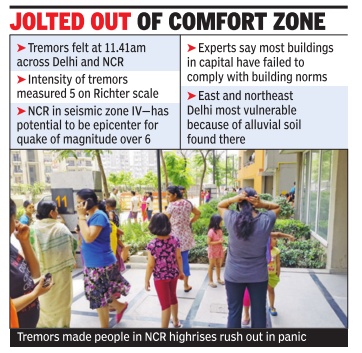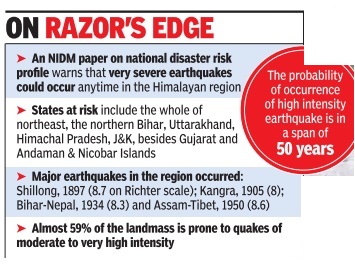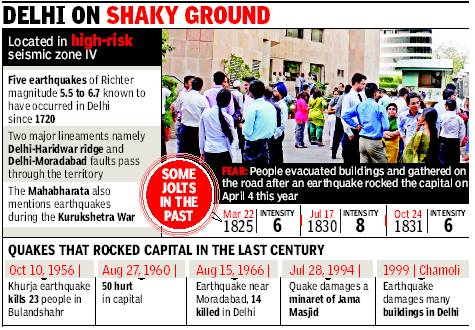Earthquakes: India

This is a collection of articles archived for the excellence of their content. Readers will be able to edit existing articles and post new articles directly |
Contents |
Earthquake: in brief
Apr 27 2015
What is an earthquake
The Earth's structure has three parts an outer silicate solid crust (till about 30 km from the surface), a viscous mantle (2,900 km thick) below the crust and a core (3,500 km diameter) at the center.The uppermost part of the mantle and the crust is broken into seven major tectonic plates--African, Australian, Eurasian, North American, South American, and Pacific. The motion of these plates against each other causes earthquakes.
How is an earthquake measured
Energy in the form of seismic waves is released after an earth quake and seismometers measure its amplitude to calculate the quake's intensity. For a long time, earthquakes were measured on the Richter scale. Since the scale was based on conditions in Califor nia and was not reliable in measuring large earthquakes, it was replaced by a `moment magnitude' scale in the 1970s.
Why is the Himalayan region more prone to earthquakes
The Indian plate, which is part of the Indo-Australian plate, is moving in a north-north-east direction and colliding with the Eurasian plate. The Himalayas came up as a result of this movement.The collision has resulted in the formation of many fault lines along the region, which has made it highly susceptible to earthquakes.
Most susceptible regions to earthquakes
The Pacific `Ring of Fire', a horseshoe shaped region encircling the Pacific Ocean, accounts for 90% of all earthquakes. This 40,000 km long stretch has 452 volcanoes and is home to over 75% of the world's volcanoes. The next most active region is the Alpide belt, which lies along Java, Sumatra, the Himalayas, the Mediterranean, and the Atlantic Ocean.
Various seismic zones in India
According to the Indian metrological department, the Bureau of Indian Standards has grouped the country into four seismic zones, from Zone V , the most active, to Zone II, the least active.Zone V consists of parts of Jammu and Kashmir, Himachal Pradesh, Uttarakhand, Rann of Kutch, part of north Bihar and the Andaman & Nicobar Islands. The remaining parts of Jammu & Kashmir and Himachal Pradesh, Delhi, Sikkim, northern Uttar Pradesh, Bihar and West Bengal, parts of Gujarat and small portions of Maharashtra near the west coast and Rajasthan fall under zone IV (severe intensity zone).
60% of subcontinental landmass is vulnerable
Thirty-eight Indian cities in high-risk earthquake zones
At least 38 Indian cities lie in high-risk seismic zones and nearly 60 percent of the subcontinental landmass is vulnerable to earthquakes. Barring rare exceptions, such as the Delhi Metro, India's hastily-built cities are open to great damage from earthquakes.
The earthquake that devastated Nepal on saturday and jolted northern India, damaging buildings as far apart as Agra and Siliguri, was expected by geologists, who have warned of more Himalayan earthquakes caused by the growing pressures of the sub-continent grinding into the Asian mainland.
Very few buildings in India meet the standards prescribed in "Indian Standards Criteria for Earthquake Resistant Design" - first published by the Bureau of Indian Standards in 1962, the latest revision being in 2005. These are not enforced, so almost no one knows such earthquake-resistant standards and guidelines for home-owners exist.
The Delhi Metro is one of the few Indian structures built to withstand a quake. Many of the houses built in Bhuj after the Gujarat quake of 2001 are now earthquake-resistant.
The government of India today lists 38 cities in moderate to high-risk seismic zones. "Typically, the majority of the constructions in these cities are not earthquake-resistant," notes a 2006 report written by the United Nations for the ministry of home affairs. "Therefore in the event of an earthquake, one of these cities would become a major disaster."
The earth's landmasses ride like gigantic rafts on "plates", or sections of the earth's outermost layer, the crust. These plates frequently slip and slide, causing earthquakes. We don't feel the small ones. The big ones, literally, shake us up.
The Himalayas and north India are on particularly shaky ground. Sometime in the geological past, before humans, India broke off from an ancient supercontinent called Gondwana, a name still used for what is now Chhattisgarh.
The Indian plate skewed north, displaced an ancient sea, travelled more than 2,000 km - the fastest a plate has ever moved - and slammed into the Eurasian plate, creating the Himalayas.
India still grinds northeast into Asia at roughly 5 cm every year. The last significant - but not geologically significant - quake in this area was the 2005 temblor in Pakistan-administered Kashmir, which sits directly atop the clashing Indian and Eurasian plates. Around 80,000 people died.
About 60 percent of India is vulnerable to earthquakes caused by the great, northward grind of the Indian subcontinental landmass.
History
But nothing has changed since 1993, when a relatively milder earthquake of magnitude 6.4 in Maharashtra's Latur district killed nearly 10,000 people in what was considered a non-seismic zone. Most died because shoddily constructed houses collapsed at the first major shake, as they did in Gujarat eight years later.
The only serious earthquake that modern India remembers is the temblor that killed about 20,000 in Gujarat in 2001. The 2004 tsunami, which resulted from the third-most severe quake ever recorded, 9.3 on the Richter scale, occurred when the Indian plate slid with greater violence than it normally does under the neighbouring Burma plate, upon which rest the Andaman and Nicobar Islands.
It caused a 100-km-long rupture in the crust, thrusting the seafloor upwards and pushing up masses of water, setting off the tsunami that killed 230,000 people in 14 countries.
No Indian metropolis has witnessed a serious earthquake, although Delhi lies in high-risk seismic zone 4. Srinagar and Guwahati are in the highest-risk zone 5, and Mumbai, Chennai and Kolkata lie in zone 3. History serves a warning that a big one may come at any time. Those lessons come from Bihar in 1934 and Assam in 1950.
Although its epicentre was 10 km south of Mount Everest, the Bihar earthquake of 1934 was felt from Mumbai to Lhasa, flattening almost all major buildings in many Bihar districts and damaging many in Calcutta, now Kolkata. At 8.4 on the Richter scale, it was pretty severe, killing more than 8,100 (Mahatma Gandhi said it was punishment for the sin of untouchability).
The 1950 Assam earthquake may have geologically set the stage for a really big one in the Himalayas, according to geologists. Now that 65 years have passed, it may be time for a big one.
(In arrangement with Indiaspend.org)
Delhi: located in ‘high-risk’ seismic zone IV
Disaster authority for stricter quake norms
Ambika Pandit TNN
The Times of India 2013/08/06
Delhi is located in the ‘high-risk’ seismic zone IV. The Vulnerability Atlas of India (1997) says for shaking intensity eight, 6.5% houses in Delhi have high damage risk and 85.5% houses have moderate damage risk. “Most buildings may not meet codal requirements on seismic resistance. Disaster prevention involves engineering intervention in buildings and structures to make them strong enough to withstand the impact of natural hazard,” said DDMA divisional commissioner Dharampal.
DDMA has observed that ill-designed high-risk areas and highrises exist in Delhi without specific consideration of earthquake resistance. “Connaught Place, numerous district centres and sprouting highrise group housing schemes are high risk areas due to the vertical development and plan configurations,” DDMA concedes. The Walled City, trans-Yamuna area, and scattered pockets of unplanned settlements also figure as high-risk zones due to their substandard structures and high density.
April 25, 2015: quake in Delhi
The Times of India, Apr 26 2015

Last time city shook so much was 55 years ago
Not since 1960 had the capital shook so much. The earthquake that rattled Delhi just before noon on Saturday was the severest in 55 years, measuring 5 on the Richter scale locally . Although no casualties were reported here, the intensity and duration of the tremors sent people scurrying out of homes and offices.Those who were stuck on high floors froze in panic and prayed with hearts drumming deafeningly . After three seismically quiet years--the last notable quake occurred in Bahadurgarh, 30km from Delhi, on March 5, 2012--the city took a few moments to realize what was happening.
The tremors started at 11.41am and continued for about two minutes. But when they were over, people hesitated to return indoors. Nobody wanted to take a chance and they looked for signs--a suspended bulb or ceiling fan that wasn't swaying. Hardly had they returned indoors when a second wave of tremors struck at 12.18pm. This time, people reacted faster, grabbing their phones and keys and making a dash outdoors. “We were downstairs for about 10 minutes when the first tremors were felt. Just as we thought the worst was over and turned on the TV for news, the tremors started again, said Nitish Saxena, a resident of Mayur Vihar Phase I.
L S Rathore, director of India Meteorological Department, which monitors earthquakes, said a temblor's intensity reduces away from the epicentre. “While the epicentre recorded 7.9 on the Richter Scale, it was about 6.5 in Gorakhpur and about 6 in Lucknow. In Delhi, the intensity was 5. On August 27, 1960, Delhi was shaken up by an earthquake that had its epicentre between Delhi Cantt and Gurgaon. About 75% of the buildings around the epicentre developed cracks and minor damage to Red Fort and Rashtrapati Bhavan was also reported. About 100 people were injured by falling debris and in stampedes. Although the quake was first classified as a magnitude-6, researchers now say it was more likely a magnitude-4.8.
To take stock of the situation, LG Najeeb Jung called a high-level meeting with CM Arvind Kejriwal, police commissioner B S Bassi, the MCD commissioners and other senior officials on Saturday evening. Officials reported hairline cracks in three buildings in the East district, two in the South district and one in North district. PWD officials checked all flyovers and reported them safe.
Delhi lies in `seismic zone IV' or an area of high damage risk from earthquakes. Parts of it lying on the Yamuna floodplains are especially vulnerable. Although earthquakes occur regularly here, most of them cannot be felt, but a magnitude 6 or 7 quake is possible and could cause extensive damage to life and property as, architects and planners say , 95% of the buildings have not been built in accordance with the safety code.Many are not certified by structural engineers and don't have completion certificates from civic agencies.
Vulnerable regions: NIDM (National Institute of Disaster Management)

Apr 27 2015
Pradeep Thakur
NE, Bihar, U'khand, J&K, Himachal, Gujarat, Andamans at high risk
An assessment made by the Centre says the entire Himalayan region is vulnerable to high intensity earthquakes exceeding 8.0 on the Richter scale which could adversely affect millions of people.
Kumar said the probability of high intensity earthquake was in a relatively short span of about 50 years. The fear stems from the fact that four major earthquakes have occurred in the Himalayan region -Shillong in 1897 (8.7 on Richter scale); Kangra in 1905 (8); Bihar-Nepal in 1934 (8.3) and Assam-Tibet in 1950 (8.6).
An NIDM paper on the national disaster risk profile, referring to scientific assess ments, warned that very severe earthquakes were likely to occur anytime in the Himalayan region. States at risk include the whole of northeast India, the northern portion of Bihar, Uttarakhand, Himachal Pradesh, J&K, Gujarat and Andaman & Nicobar Islands.
As part of risk mitigation effort, the government has put greater emphasis on capacity building. This comprises collating scientific data from the Indian Space Research Organization, Geological Survey of India and other government departments to make timely predic tions of natural disasters and initiate preventive measures and plan rescue operations.
Earlier this month, the government had revised its norms for assistance provided to disaster-affected people through the state and national disaster response funds.The compensation, effective April 8, was increased to Rs 4 lakh per deceased, including to those involved in relief operations and assistance work, besides enhanced payment for the injured and the affected population.
The assessment paper said of the 36 states and Union Territories, 27 were disaster prone from phenomena such as earthquakes, floods, river erosion, cyclones, tsunamis, drought, landslides and avalanches. Almost 59% of the landmass is prone to earthquakes of moderate to very high intensity. The high risk states are those which fall in the high seismic zone V . Some cities in these states have high density of population and face maximum risk of loss of lives and property .
The NIDM paper warned that “constructions in these cities are predominantly not earthquake resistant, regulatory mechanisms are weak, thus any earthquake striking in one of these cities would turn into a major disaster“.
